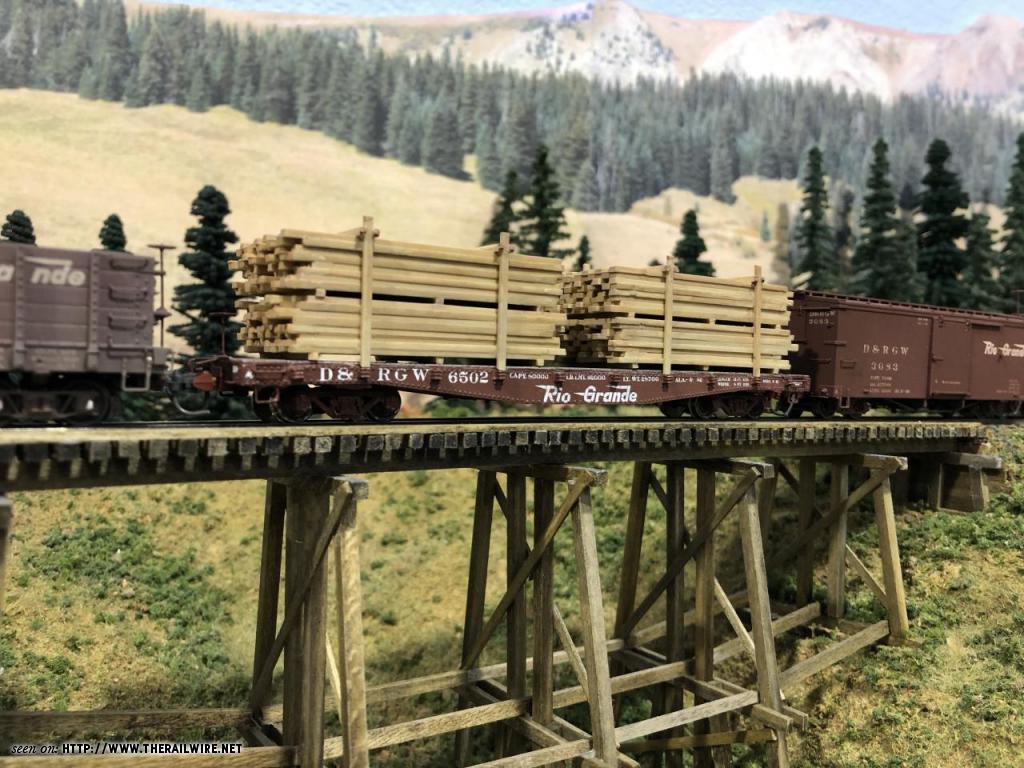Long update.
I finished that outfit car kit from Narrow Gauge Colorado:


The RGS moved a lot of lumber. There was a huge sawmill at McPhee, connected to the RGS at Dolores via the Montezuma Lumber Company's narrow gauge railroad. It also appears the RGS received lumber from the D&RGW via the Ouray Branch, probably originating at Cimarron and Sapinero on the 4th Division.
So...How to model lumber? With plastic, of course! Owl Mountain Models makes plastic lumber loads that are really fun and easy to work with, and with a bit of artistry can be made to look like raw wood. In fact, the base color is extremely realistic, so a little thin washing and drybrushing along with some brush-on Dullcote was all that was required to finish it:
http://www.owlmtmodels.com/lumber/3004_3005_Narrow.htmlI built a Precision Scale kit for a D&RGW 6500-series 40-ton capacity 40' flat car. The prototype for this series were built from standard gauge flats. The D&RGW simply narrowed them and put them on AC&F cast narrow gauge trucks.

So I wanted to model a specific prototype:
D&RGW6502With luck, the narrow Owl Mountain load, designed to fit inside standard gauge gondolas, happened to fit the width of the 6500-series exactly. The result:


I made that load permanent on that car.
I still had a lot of leftover bits. The Blackstone 6000-series D&RGW flats are a bit narrower even than the 6500-series. While they were nominally 20-ton capacity, they were worn out and attrited to single numbers by the 40s, so they were loaded to less than their 20 ton capacity. The good news is that if I narrowed the Owl Mountain load by one board, it would fit perfectly.
I made this load removable:

So now I'm hauling cut lumber just like the real RGS:

The difference in capacity between the nineteenth century car and the modern steel car can be illustrated nicely.
I replaced the older-style electric box headlight for a Pyle national headlight on 347. This is the headlight she wore from 1935 to 1938.

This locomotive came to me undecorated with a green boiler. I lettered her for RGS 17 with a planished iron boiler. Later I changed her to D&RGW 347, since that's the engine the undec was based on. However, there's at least one more change awaiting the 347.
I was able to get my hands on a limited run of San Juan Central decals!
So... The story goes that in 1938, as the 347 was whitelined and ready for scrapping at Salida, the San Juan Central purchased her for one dollar above scrap value. At the time, the RGS Ridgway Shops had been reorganized under receiver Victor A. Miller, so the RGS was actually able to underbid the D&RGW for the overhaul on 347. 347 was hauled dead in tow from Salida all the way to Ridgway. After a year in the shops, the 347 emerged in new San Juan Central paint (but, in keeping with SJC practice, kept her former D&RGW road number). Since the Ridgway crew were working on their now-famous RGS "Sunrise Herald," they made a similar herald for the San Juan Central. The SJC, eager to be associated with the slightly more successful RGS (which is really saying something!), promptly acquired the SJC stencil and lettered their other two 2-8-0s (360 and 361) and caboose 0400 to match.
The Micro Trains HOn3 steel under frame flatcar is based on a C&S prototype. You can get it lettered in a number of schemes. Most come with arch bar trucks, but the one lettered as a D&RGW 6000-series truss rod flat (which had arch bar trucks IRL) comes with cast steel trucks. It clearly looks nothing like the 1890s-era truss rod flat car it's lettered as, but with the C&S cast steel trucks it
is a very good approximation to one of the RGS flats converted from steel underframe C&S stock cars. I added the grab irons, steps, and coupler lift bars and gave it a new paint job. RGS stock car 7451 was cut down to a flat car in 1942 and used mostly by maintenance of way crews.

Model railroading also means modeling railroading...which means purposeful movements of cars and lading...which means paperwork! At this point every car and locomotive on or off the layout is accounted for. I’m developing four-cycle waybills to be used with each car to show where it’s coming from, where it’s going, who shipped it, who ordered it, and what’s in it. The beauty of modeling a real railroad is that there are real train sheets and shipping records to help guide me. To start I’m keeping it simple...we have a certain number of online industries (mostly mines) that require certain car types in and out and that ship to specific destinations. For example, yellowcake ships from Placerville to the uranium smelter at Durango. And so on.

